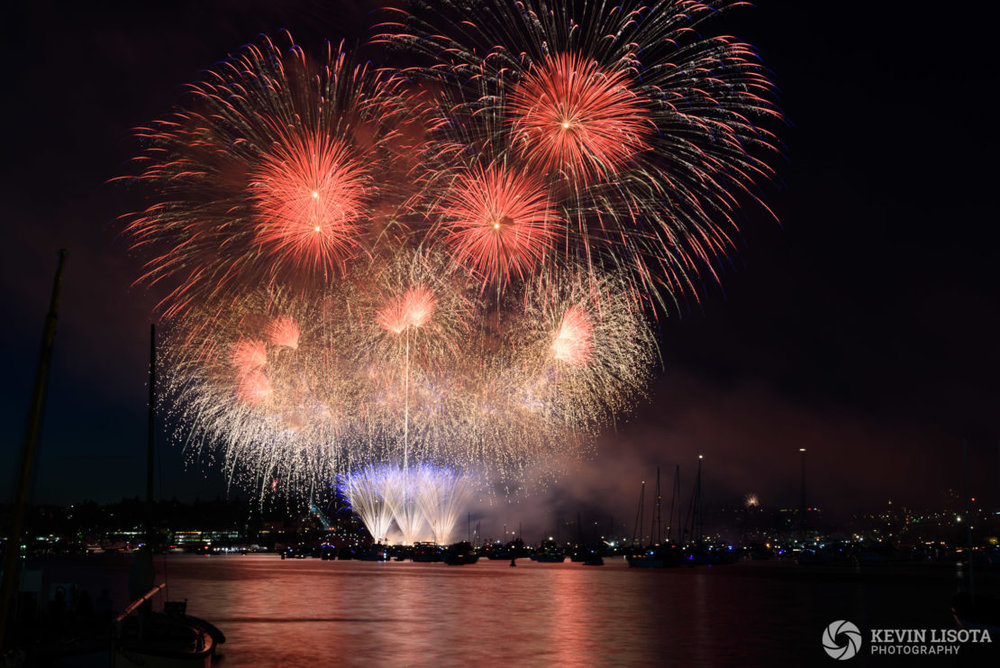
Fourth of July Fireworks at Seattle’s Gas Works Park. Nikon D810, 70mm, 8.0″, f/9.0, ISO 100
Millions of people will be taking photos of fireworks this week, and millions of those photos will be poor. Taking compelling photos of fireworks isn’t all that difficult but does take a little bit of advanced planning and gear.
Fireworks need a tripod
If you want good photos of fireworks, you need a tripod. The average firework shell may take 1-5 seconds to burst, and you simply cannot hold the camera steady for that amount of time.
Camera for fireworks
Almost any DSLR, mirrorless or point-and-shoot camera can be a great fireworks camera, provided that you have it on a tripod.
Many consumer-focused cameras even have a dedicated fireworks mode that can be useful if you are frightened away by exposure settings like aperture, shutter speed and ISO.
Lens for fireworks
You do not need a fancy or expensive lens to shoot awesome fireworks photos. Fireworks are sufficiently bright that shooting at an aperture of f/8 is more than sufficient and will get you optimal sharpness from most lenses.
In general, you want a wide-angle lens for fireworks. I shoot the large fireworks show on Seattle’s Lake Union every year and I end up using a 24mm focal length on a full-frame camera. This would translate into a 16mm lens on an APS-C crop-sensor camera. I am usually very close to the show at these wide focal lengths.
Focal length obviously depends on how far away you are from the show, but every time I shoot the fireworks, I underestimate just how tall the largest shells are and find myself zooming out.
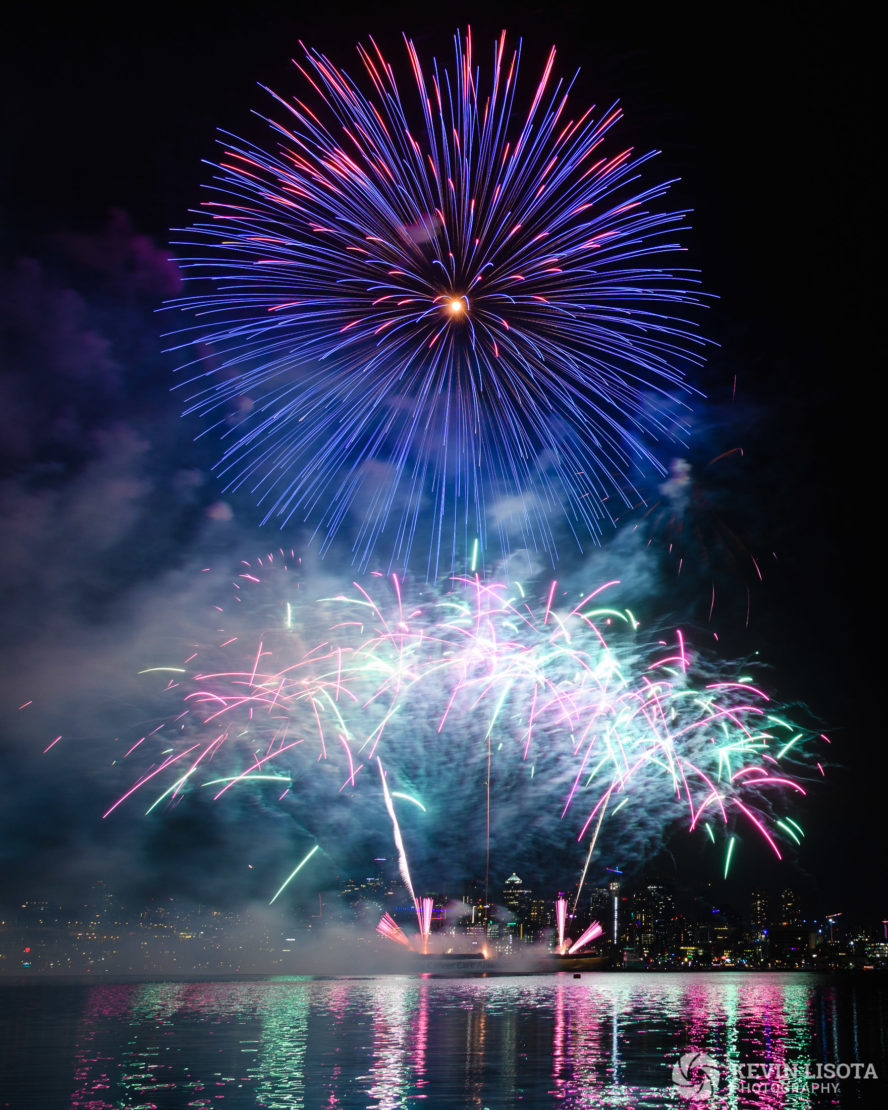
Fireworks on Lake Union. Nikon D850, 24mm, 1.6″, f/8.0, ISO 250
If you are feeling creative or plan to operate a second camera, zoomed in shots can also be interesting. There can be groundworks or crowd elements that can be an opportunity to try a shot with a 70-200mm telephoto lens, for example.
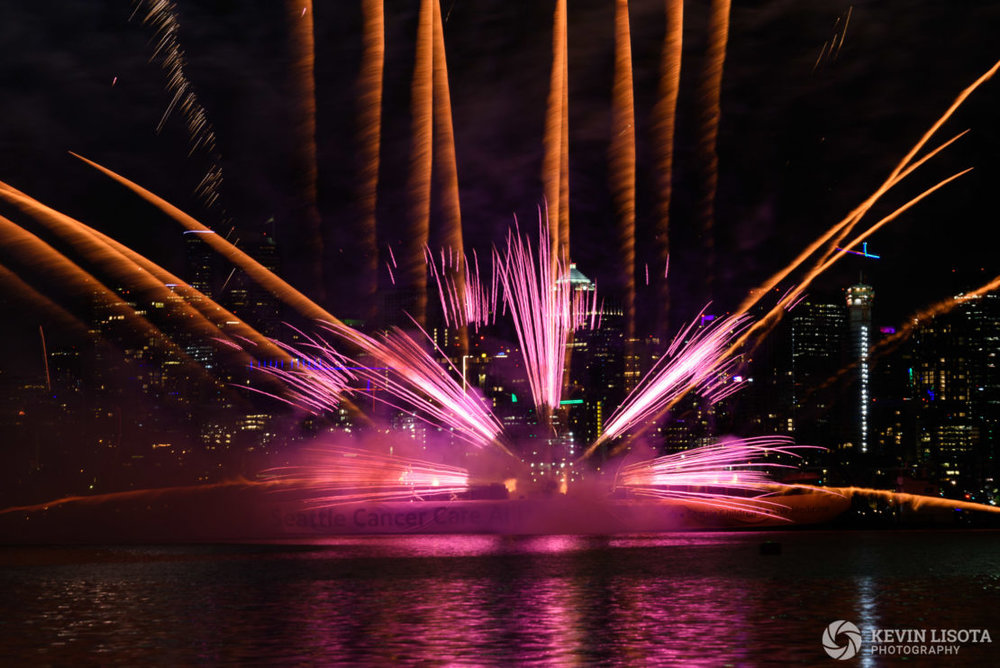
Groundworks on Lake Union. Nikon D810, 135mm, 1.3″, f/9.0, ISO 320
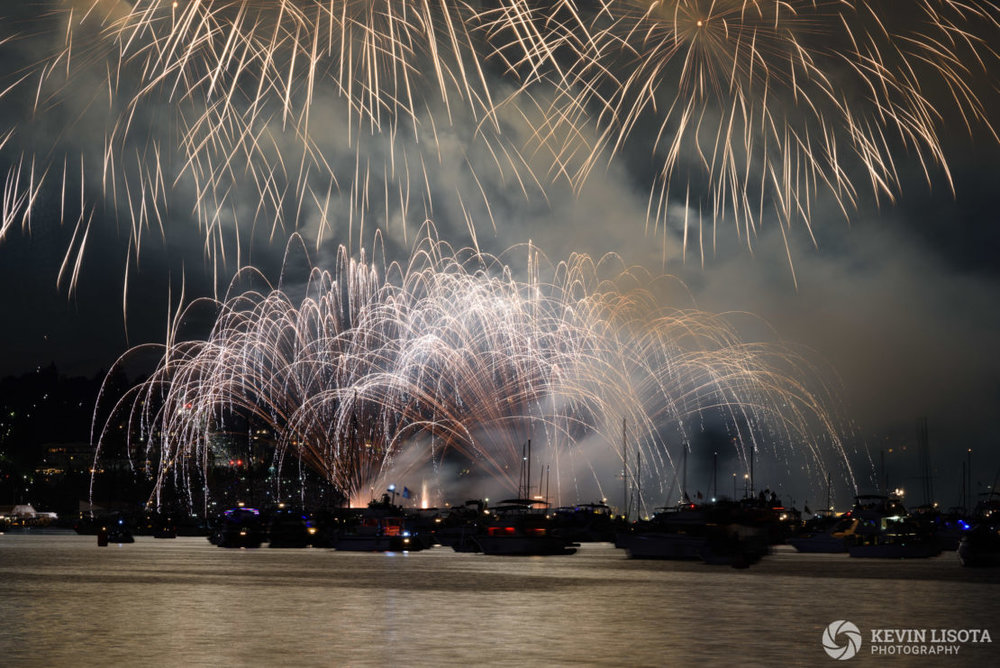
Boats on Lake Union. Nikon D810, 200mm, 8.0″, f/9.0, ISO 100
Focus for fireworks
Fireworks are quite bright, and most cameras would have no problems with auto-focusing on them. The challenge is that you may often trigger the camera before a fireworks burst when the sky is blank and there is nothing to focus on, so you need to set your camera to manual focus mode.
You are going to be a considerable distance from the actual fireworks. Before the show begins, find a distant light or building and focus on that to set your camera at infinity focus. Then switch your lens or camera to manual focus mode so that the auto-focus motor doesn’t change the focus each time you press the shutter. You may want to bring a piece of gaffer tape to secure the lens focus ring so that you don’t bump or change it.
If your location is very dark, here are some more tips about finding infinity focus at night.
Exposure settings for fireworks
First of all, remember to turn off your flash, if your camera has one built in. A flash will add nothing to fireworks photos, other than messing up the foreground and underexposing the actual fireworks.
If you aren’t comfortable with manual exposure settings and your camera has a dedicated fireworks mode, go ahead and use it. If you are familiar with camera exposure settings like aperture, ISO and shutter speed, put your camera into manual exposure mode.
I generally shoot fireworks at an aperture of f/8. What about shutter speed and ISO?
Shutter speed is the most important setting here. Fireworks bursts develop over time and some linger in the air for quite some time. You want a shutter speed that is long enough to capture an entire burst. Anything shorter than 1 second often will give disappointing results.
I have shot ~10 fireworks shows over the past years and have experimented with various shutter speeds. If you are in a city with a large and dense fireworks display, a shutter speed of 2.0-4.0 seconds will often be able to isolate some of the bursts.

Space Needle New Year’s Fireworks. Nikon D850, 70mm, 4.0″, f/8.0, ISO 100
I’ve also shot as long a 6-10 seconds which captures many more bursts in the scene. In very dense fireworks shows, this can lead to too many bursts in the shot, which may or may not be what you are after. In smaller shows, using a longer shutter speed may improve the shot by adding more bursts into one picture.
There is no right or wrong answer to shutter speed, and I encourage you to experiment somewhere in the 2″-10″ range.
Given the brightness of fireworks, it is not necessary to have high ISO settings and something like ISO 100-320 should be sufficient. In fact, you want to make sure that you don’t overexpose the fireworks. Here is a rundown of the exposure settings I’ve used for the past few shows:
1.6 seconds, f/8.0, ISO 250
8.0 seconds, f/9.0, ISO 100
6.0 seconds, f/9.0, ISO 200
4.0 seconds, f/8.0, ISO 100
10.0 seconds, f/8.0, ISO 100
If you know how to read your camera’s histogram, turn it on and you can check that you aren’t overexposing by checking the first few shots.
Composing your shot
It does help to arrive early at your shooting location to get setup. It is much easier to accomplish this before the place is packed with crowds of people.
Try not to point your camera directly up in the sky. This leads to boring pictures. The best fireworks photos include some landscape element, whether that is a city skyline, buildings, trees or crowds.
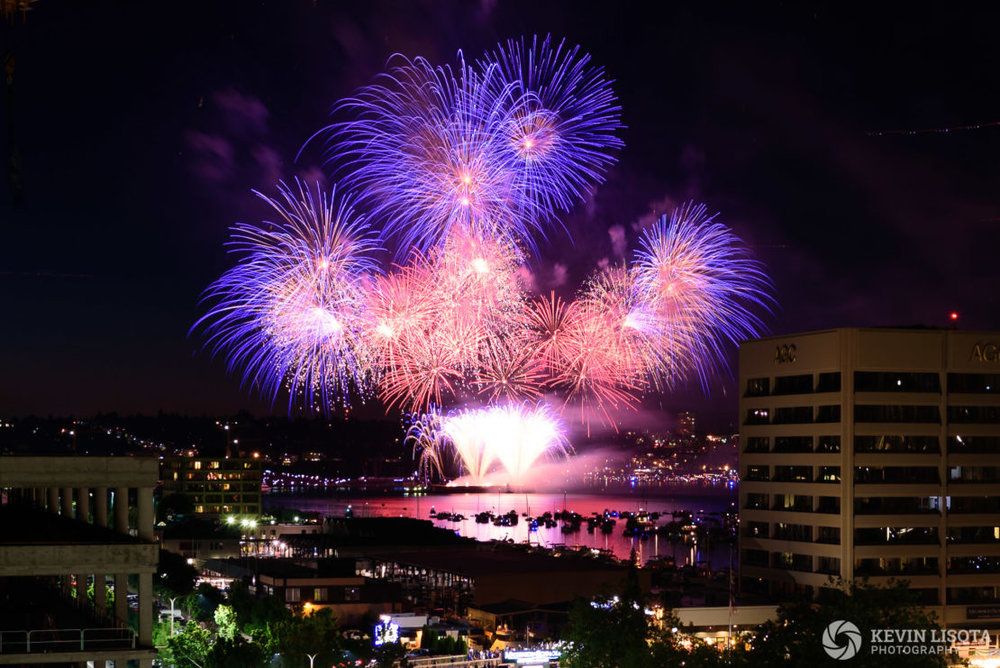
4th of July Fireworks over Seattle’s Lake Union 2015. Nikon D750, 24mm, 6.0″, f/5.6, ISO 100
Don’t forget about the crowd. Pictures of people enjoying the fireworks can be compelling, and it is all too easy to forget to turn around a snap a shot of people’s reactions. In this photo I was annoyed by the woman in front of me who was wildly waiving the flag, but it actually made the shot more interesting.
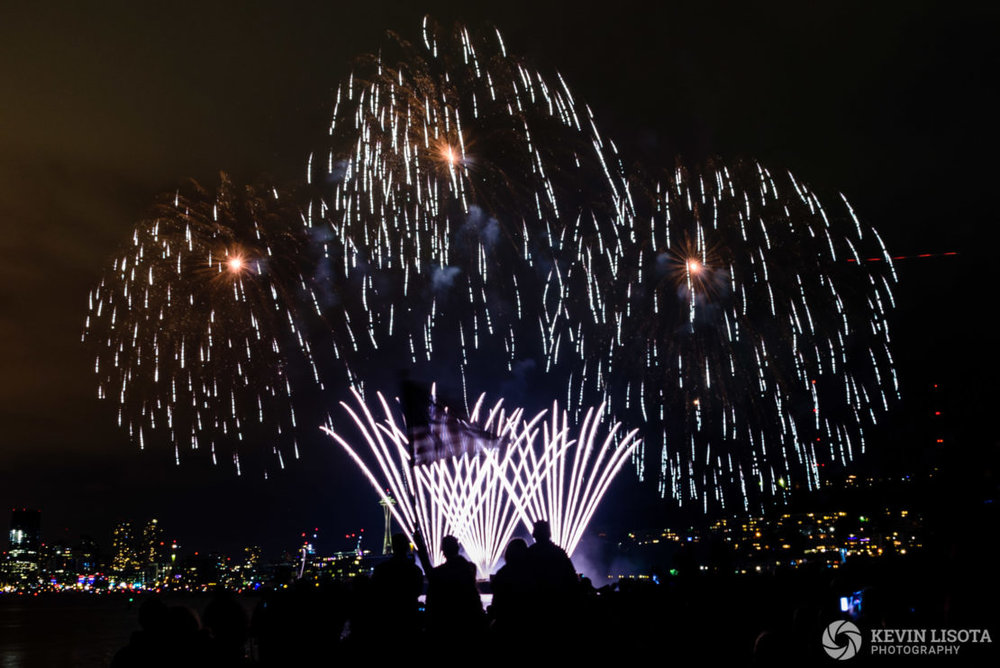
Crowd waives a flag at Seattle’s Lake Union fireworks. Nikon D810, 24mm, 5.0″, f/9.0, ISO 200
Watch out for smoke
Large fireworks displays can create a lot of smoke. Some of the best fireworks photos will be in the first minute or so before there is too much smoke.
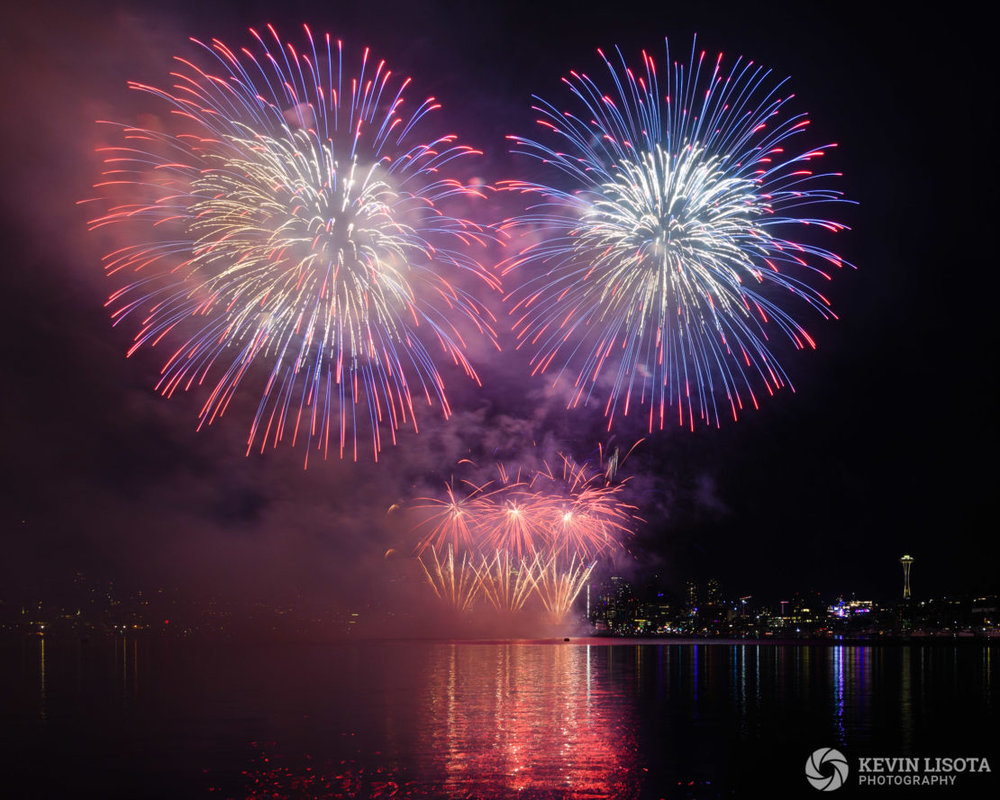
Fireworks and smoke over Seattle’s Lake Union. Nikon D850, 24mm, 1.6″, f/8.0, ISO 250
If the air is still, there isn’t much you can do about the smoke. If there is wind, try and position yourself in an upwind shooting location so that the smoke moves away from you during the show.
How to trigger the camera
Since you will be shooting long exposures of the fireworks, it is important that you do not shake the camera by pushing the shutter button. There are a few ways to avoid this:
Turn on a 2-second shutter delay. Most cameras have a capability like this which allows you to press the shutter button and it will take the photo 2-seconds later. This is easy, but difficult to time fireworks bursts.
Use a cable release. This allows you to trigger the shutter without touching the camera and cable releases are quite inexpensive.
Use your camera’s smartphone app. Many cameras are able to connect to a smartphone app via Bluetooth or WiFi, allowing you to trigger the shutter on your phone. This normally works well, but if you are in a crowd of thousands or tens of thousands of people, wireless networks can fail because there are simply too many other phones around. I don’t recommend this unless you test it with a crowd around.
Trying to time exactly when fireworks will burst in the sky isn’t easy or intuitive. For many years, I used a cable release and just kept pushing the shutter over and over when I thought the next batch of fireworks was coming. You will take a few hundred photos, and many won’t be great, but this maximizes your potential to capture the interesting ones.

Fireworks fall in front of Seattle’s Space Needle. Nikon D810, 70mm (cropped), 6.0″, f/9.0, ISO 200
For the last couple of fireworks shows that I shot, I simply used the intervalometer on my camera to take shots at 1″ intervals, allowing me to enjoy the show without having to press the shutter. Some cameras have this capability built-in, while other cameras may need an intervalometer accessory.
These shows are pretty short at 15-20 minutes. Take as many photos as you can. Sift through them at home and discard the boring ones, but if you are continuously shooting, there will be some keepers in the mix.
Enjoy the show
Don’t forget to enjoy the show. It is easy to get wrapped up in your camera settings, but allow yourself a few “oohs” and “ahhs.” Remember, if you don’t get the shot, there is always next year for fireworks!
~ Kevin Lisota
View Post on Original Blog
https://muenchworkshops.com/blog/how-to-shoot-awesome-fireworks-photos
